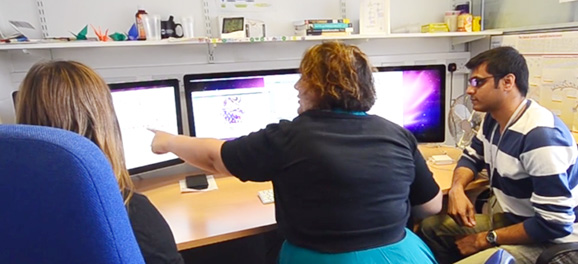
Our scientists identified 46 previously overlooked but potentially 'druggable' cancer targets, using a powerful new online knowledgebase called CanSAR.
CanSAR was developed by The Institute of Cancer Research, London, with funding from Cancer Research UK, allowing researchers to carry out 'virtual experiments' to quickly prioritise which are the best targets for drug discovery.
While world-wide initiatives in cancer genomics are generating unprecedented volumes of cancer data, the translation of these genome data to drugs has been a slow and increasingly daunting process. This is mainly due to the amounts of information from different disciplines that need to be collated and examined to form this bridge between genome data and drug prototypes.
In response to this challenge, Dr Bissan Al-Lazikani and her team have created CanSAR – a cancer knowledgebase that integrates vast amounts complex data from patients, clinical trials and genetic, biochemical and pharmacological research. CanSAR scans these data and uses artificial intelligence, like that used in weather forecasts, to predict which potential drugs are likely to work in which circumstances.
Demonstrating the remarkable potential of CanSAR, the team analysed the Sanger Institute's existing list of 479 cancer genes. They found 46 potential protein targets that had until now been ignored despite their known biological relevance to cancer. These results show that, using this approach, we can find targets for cancer drugs in a smarter and faster way than ever before, paving the way for research into promising new drug targets that until recently may have been overlooked because of a lack of information. The analysis was carried out using the prototype of CanSAR, and a new version of the knowledgebase was launched in November this year. The new version now contains more than one billion experimentally derived measurements, nearly one million biologically active chemical compounds and data from over a thousand cancer cell lines. It also contains drug target information from the human genome and model organisms.
The clues needed to tackle cancer are hidden in data like this and by making it freely available to scientists across the globe, researchers can collaborate and make breakthroughs sooner. By selecting the very best targets that are most likely to lead to successful drugs, the success rate in the clinic increases. Not only will this speed up drug discovery and operate at a lower cost compared with traditional routes, but it will enhance innovation – shifting the focus away from tried and tested drug targets while managing the inevitable risk associated with moving into new and exciting areas. Both patients and the pharmaceutical industry will benefit tremendously from these advances.